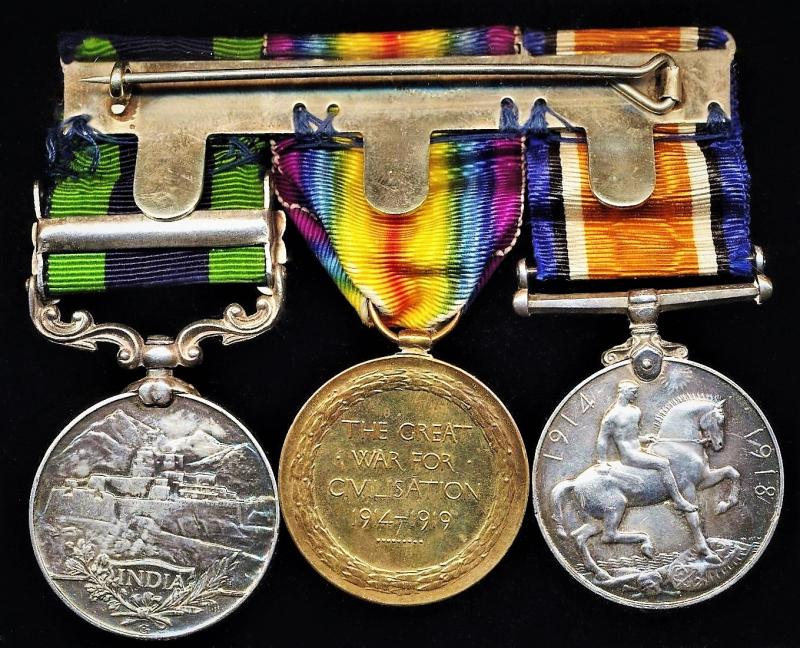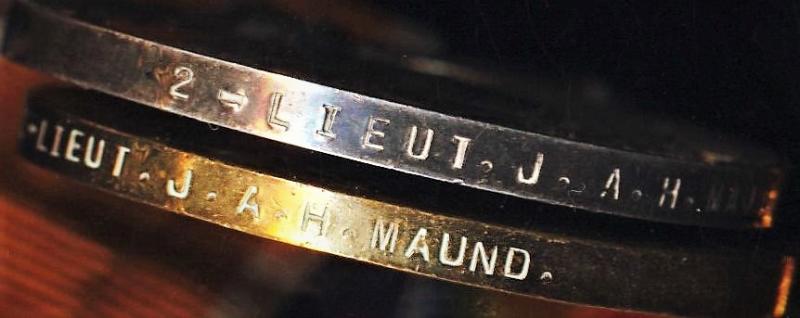An Officer's' Great War & 'Waziristan' campaign medal group of 3: Captain John Anthony Hansby Maund, District Officer Colonial Administrative Service (Nigeria) late 2nd Battalion (Queen Alexandra's Own) 3rd Gurkha Rifles, and 6th Gurkha Rifles
- British War Medal. Silver issue (2-Lt. J. A. H. Maund.)
- Interallied Victory Medal (2-Lt. J. A. H. Maund.)
- IGS Medal 1908-35. GV 1st issue 'Waziristan 1919-21' (Lt. J. A. H. Maund. 2-3 Grks.)
Note: The IGS medal with minor official corrections to the last 2 x letters of surname & battalion number only - exactly as issued from the Calcutta Mint, and fairly typical thus
Medals verification: The Great War campaign medals confirmed as entitled per the respective medal index card(s) cited below:
- British War Medal. Silver issue: Medal Index Card 3/6 Gurkhas confirms Ref WO 372/27/2577 issued by Government of India Authority
- Interallied Victory Medal: Medal Index Card 3/6 Gurkhas confirms Ref WO 372/27/2577 issued by Government of India Authority
- India General Service Medal: Shrewsbury School Register shows served in India, Egypt, Palestine, Waziristan – Tochi Valley Force, 1921/22
John Anthony Hansby Maund, first child of Dr, John Hansby Maund (a Newmarket based surgeon) & Claire Anontia Maund (nee Noding), was a native of Newmarket, Cambridgeshire, England, where he was born on 25 December 1898. John was educated at Shrewsbury School, which school he left in 1916, prior to joining the Indian Army. The Shrewsbury School Register has the following entry for John: 6th Gurkha Rifles, Indian Army: served in India, Egypt, Palestine, Waziristan – Tochi Valley Force, 1921/22; Lieutenant. Resigned Indian Army 1923
Wellington Cadet College, Nilgiris, India: The teenagerJohn - the teenager - chose to join the Indian Army, and entered the Wellington Cadet College, Nilgiris, in Madras Presidency, in 1917. Cadet Maund passed out (apparently last – but not least) from Wellington Cadet College as a 2nd Lieutenant on 31 January 1918, together with a hundred erstwhile Cadets of his batch. John Anthony Hansby Maund was admitted to the Indian Army from the Unattached List on 11 February 1918. He was 'attached' to the 'war raised' 3rd Battalion 6th Gurkha Rifles (April 1919 Indian Army List) refers, having joined on 21 February 1918 as a Company Officer. The Indian Army List of, January 1922, listing 'War Services' of British Officers of the Indian Army, shows his entry:- J. A. H. Maund – The War of 1914-19. – Operations with Egyptian Expeditionary Force, October 1918
3rd Battalion 6th Gurkha Rifles: Was raised at Rawalpindi in February 1917, the battalion was named 3rd Reserve Gurkha Rifles but this was later changed to 3-6 Gurkha Rifles. In May 1919 the Third Afghan War broke out and the Battalion moved from Bannu to Dardoni. This was a strong defensive position, but the expected attack never materialised. Lieut. Maund did not qualify for the clasp Afghanistan N.W.F. 1919, as he had been posted away from the battalion - most likely to another Gurkha Rifles battalion on attachment. From June to November 1919, 3rd Battalion, 6th Gurkha Rifles was employed with patrols, road protection duties, and minor skirmishes. Following three months on duty in Peshawar, 3-6 Gurkha Rifles shifted to Abbottabad and the Mountain Warfare School in March 1920 (serving as a Demonstration Battalion).3-6 Gurkha Rifles was disbanded in February 1921
2nd Battalion 3rd Gurkha Rifles: 2nd Battalion, 3rd Gurkha Rifles returned to Abbottabad in November 1919 and reorganised to its reduced post-war establishment. In October 1920 2-3 Gurkhas deployed in Waziristan to help deal with unrest in the aftermath of the Third Afghan War. A number of sharp clashes with the tribesman followed during the next two and half years as a result of which ten decorations for gallantry were awarded to members of 2nd Battalion.
Retirement under provisions of the Royal Warrant: London Gazette of 20 April 1923 lists Lieut. J. A. H. Maund as last on the list of retirees, probably with a Gratuity, dated 1 April 1923. From Lieutenant to Captain: The London Gazette of, 5 October 1923, announced the promotion of J. A. H. Maund to the rank of Captain, dated 31 January 1923
Colonial Administrative Service (Nigeria): For a young, recently retired former Indian Army officer in 1923, the life of a District Officer in Nigeria could well have had more appeal (despite the White Man’s Grave connotations), compared to a civilian career in the United Kingdom, a career in Nigeria, came with plenty benefits not least good pay and benefits as well as a generous pension to compensate for the obvious dangers of life in tropical Africa. The Blue Book Nigeria 1938, shows Capt. John Anthony Hansby Maund having been appointed as an Assistant District Officer under the Colonial Government on 5 August 1925. He served in Northern Nigeria 1925 to 1952. As a District Officer under the Provincial Administration, by 1938 he earned 840 Pounds per annum, plus 72 Pounds as a Seniority allowance for Quarters. District Officer Maund spent over a quarter of a century in the Northern Provinces. The latter part of Maund’s unusually long Nigeria service of 35 years (1925-1960), was probably spent in less-arduous administration service, possibly in Lagos. During the period of his service, Maund returned to England on leave several times:- his first leave was in 1927, the 28 year-old Maund arriving from Lagos at Liverpool on,13 March 1927, and with arrangements to stay at an address in Suffolk.Then followed a four-year interregnum until 1931: this time he arrived at Liverpool again, on 15 September 1931.A four-year gap followed when, aged 34, Maund arrived at Liverpool and stayed at a Military Club at 98 Piccadilly, London W1; and again two years later (4 December 1935). The Second War obviously restricted travel to the United Kingdom, but nonetheless, April 1940, found District Officer J. A. H. Maund (aged 41) engaged in serious matrimonial affairs at Watford, Hertfordshire. He was married to the twenty-two year old Sheila Julia Dillon (born in 1918). The final retirement began when Maund (61) disembarked for the last time at Liverpool Docks on 28 December 1959. At that time he was described as an administrative assistant c/o National & Grindlays Bank, 54 Parliament Street, London SW1, and apparently possessed joint U.K. and Nigerian citizenship.
Death of a 'Son of Empire': Captain J.A.H. Maund died at Oxford , England, on, 29 July 1981, at the age of eighty-two
The medals mounted in the swing-style suspended from their silk moire ribands, the IGS riband with some fraying, and as-worn by the recipient. The mounting bar complete with original long hinged pin & clasp fittings, on stitched ribands
Condition: GVF
Code: 22506






